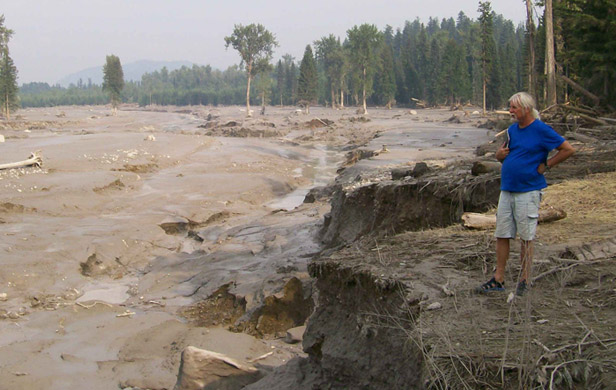
A series of anecdotal reports of illness from suffered by people in close proximity to the Mount Polley Mine tailings dam breach is prompting a local First Nation to push the premier for a study of potential airborne contaminants – and calls for an independent inquiry into the still-unfolding disaster.
“I was very sick”
Sylvia Palm is a 40-year resident of Likely, BC. Her home, near Cedar Point Park on Quesnel Lake, is 5 km northeast of Hazeltine Creek, where debris began flowing out of Polley Lake after Imperial Metals’ tailings dam burst on August 4.
At that moment, early in the morning, Palm was sleeping upstairs with the doors and windows wide open, to keep cool from the summer heat. Later that BC Day, as water and sludge from the breached pond rushed towards Quesnel Lake, she she began to realize “something wasn’t right.”
[quote]By 1 pm, I started to feel burning and irritation in my eyes and nose.[/quote]
Palm knew she had to get out of town. By 3 pm, she had left the Likely area.
She would return on Wednesday, only to pack a few things in order to relocate to her sister’s, some 20km away. She spent the evening in the house, this time with the doors and windows closed.
“When I woke up, I was very sick,” Palm recalls. “My eyes were sore, my nose was burning, and I had this intense headache concentrated in my forehead – unlike any I’ve ever experienced.”
That morning, she left to stay at her sister’s, where she remains today.
[quote]As soon as was I out of the area, things began alleviating quickly, but it was a full 48 hours before I felt remotely normal – although I wouldn’t say that I’ve felt truly normal since.[/quote]
Film on the water
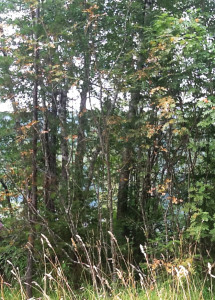
After spending the next four days at her sister’s, Palm returned home for just an hour a day on Monday, Tuesday and Wednesday of this week. She went back mainly to take water samples, photos and video of her property. “Every time I go back, I feel my face burning in my nose membranes and eyes,” Palm says.
What she saw was troubling. She observed browned foliage on mountain ash, hazelnut trees and poplar. She also captured the video below of a pail of water drawn from her underground spring. She is in the habit of filling a pail with the frigid water and leaving it outside to warm up before watering her plants with it. Thus, the pail in the video was exposed to the open air on her property from August 7th – the day she left for her sister’s – to the 13th, when the video was taken.
What it shows is a milky film on top of the water:
Just a few days earlier, documentary filmmaker Jeremy Williams recorded an oily film on top of the water flowing down Hazeltine Creek, near the mouth of the breached dam. Williams, who has done lots of documentary work in the region in recent years, headed there with his camera soon after he learned of the disaster.
Besides filming the physical devastation, Williams interviewed a number of locals who described to him experiencing a range of symptoms – from nausea and vomiting to burning eyes and respiratory difficulties – while attending the site in the early hours and days following the dam’s blow-out (watch for video of these interviews in the coming days).
Filmmaker feels the burn
Williams himself experienced short-term health effects during and following the approximate 1 hour he spent on Hazeltine Creek, near the dam, on Friday, August 8.
According to him, “a small amount of water was still cascading from the rupture area, so some of the water was airborne through mist.” In that short time, he developed a headache and his eyes started to burn.
[quote]After leaving the area, I noticed my lungs feeling weak, like I couldn’t catch my breath.[/quote]
It took 2 days for Williams’ breathing to return to normal, while the burning sensation in his eyes lingered for a day and a half.
Facebook posts ignite concern
Meanwhile – as Mike Smyth noted in his province column yesterday, calling for an independent review into Mount Polley – environmental activist David Clow has been stirring up concern on facebook with his widely-read posts on the disaster.
On August 9, he wrote the following:
[quote]Attempting to fall asleep last night, I kept asking why I did this to myself. I have never felt like I did after being exposed like I was last night. I was so ill that I wrote a list of symptoms, not expecting to be able to remember. They included: vomiting, dry heaving, upset stomach, dizziness, motor control delays, continuous blurred vision, throbbing and hot cheeks, heavy eyelids, pain in and around the eyes, lethargic in action and thought, blacking out of vision, tiredness, and headache.[/quote]
Clow would later add, “You don’t need a white lab coat to understand that this is poison. The smell here makes your vision blur and gives you a headache.”
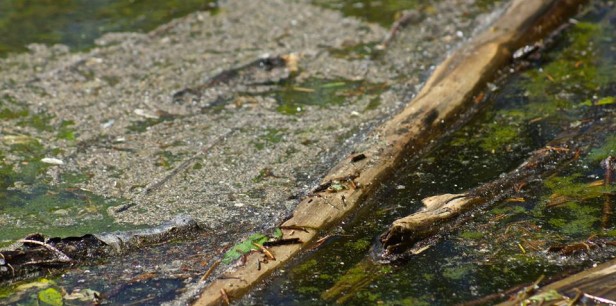
“They should be testing for airborne contaminants”
Rick Holmes is a Registered Professional Biologist whose company, Cariboo Envirotech, acts as the local Soda Creek First Nation’s Mining and Mineral Exploration Coordinator. Though he wasn’t at the site at the time of the initial incident, he too received numerous reports of a strong smell in the air at the time.
After listening to a number of community members’ concerns, Holmes feels it’s high time for the provincial government to begin studying potential air impacts from the disaster.
He told me that his client, Soda Creek First Nation, sent a letter today to the premier, urging such steps.
[quote]They should be testing for airborne contaminants as soon as possible. [/quote]
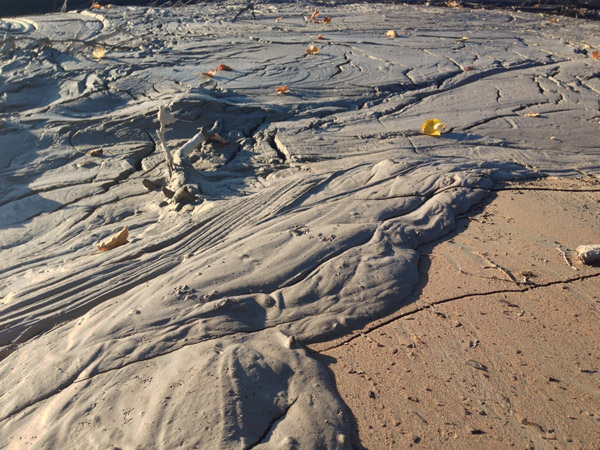
Holmes’ concerns are compounded by the drying out of parts of the flood zone in recent days, which he fears could lead to more airborne contaminants when the debris caked onto trees and the banks of Hazeltine Creek turns to dust.
At 9 pm Wednesday, he emailed Jennifer McGuire, Executive Director, Regional Operations for Environmental Protection at the Ministry of Environment, asking: “Are investigations of the impact of airborn contamination being undertaken? I noted in my flight of the area 2 days ago that considerable sized areas were drying out and I’m wondering if contaminated dust is being broadcast.”
“Additionally is it safe for cleanup crews to be handling the wood debris without dust masks at the very least? Are gloves sufficient…what about protective clothing…do the contaminants get absorbed by the skin through clothing or by not wearing gloves?” Holmes asked, regarding community members who have been engaged to perform initial cleanup work.
At 8:30 this morning, McGuire wrote back:
[quote]The ministry is aware of the emerging dust issue related to the breach. Arvind Saraswat – the Ministry Air Quality Section head and former Air Quality meteorologist in Williams Lake – is working on assessing the dust situation and will be providing information/direction to the company regarding suppression and mitigation needed. Arvind will be in touch with you.[/quote]
This evening Holmes told me that Saraswat attempted to contact him today, but they were unable to connect as Holmes has been in the field, further investigating the situation on the ground. He hopes to speak with the ministry official tomorrow to see what steps the government is prepared to take.
Chemical contaminants part of equation?
Though he’s not a toxicologist, Holmes acknowledged to me the presence of other potential contaminants besides heavy metal tailings in the mining process which may be of concern. He has worked around mining operations, including Mount Polley – also a client of Cariboo Envirotech.
One such set of contaminants, used in the milling process – after ore has been mined from the ground – is referred to as “chemical reagents”.
According to John Werring, a salmon biologist with the David Suzuki Foundation, the two main chemical reagents being used at Mount Polley – acknowledged by Imperial Metals – are sodium diethyl dithiophosphate and potassium amyl xanathate. “The problem with mining operations in Canada is that, for the most part, the kinds and amounts of chemicals that are used to extract the ore are trade secrets and therefore are not reportable in any kind of a forum or database.” Thus, mines like Mount Polley don’t need to report the concentrations of these chemicals in the materials they discharge into the tailings reservoirs.
Werring’s not jumping to any conclusions about potential health impacts from these chemicals, but he does feel there are many unanswered questions surrounding the issue, given the toxic nature of these substances.
“These two particular chemicals are highly toxic,” Werring warns.
[quote]Sodium diethyl dithiophosphate is a level three poison. It has impacts on human beings and…it’s specifically stated is highly toxic to aquatic life. Potassium amyl xanathate, similarly, is highly toxic to aquatic life. What we don’t know is how much has been discharged in these tailings, we don’t know the fate of these potential chemicals once they get in the tailings pond.[/quote]
An independent 2011 report conducted for two First Nations and Mount Polley Mining Corporation by Brian Olding & Associates found that, “On an annual bases, based on water use and production, Mount Polley produces a value of approximately 7 mg/L [of potassium amyl xanthate]”. According to Werring, these are levels “higher than can support aquatic life”. That said, the report stipulated, “the vast majority of this will actually bind to the concentrate solid and will not be found in the water that is sent to the tailings pond.”
Werring responds: “That’s a wonderful statement to say, but nobody is measuring.” Moreover, “There is absolutely no mention of the kinds and concentrations and the treatment of sodium diethyl dithiophosphate, which is even more toxic.”
Even the heavy metals in Mount Polley’s tailings, which are not ordinarily subject to acid rock drainage,when contained under water, are now exposed to weathering, says Werring. That creates the potential for acid rock draininage, oxidation and other changes that could render them more harmful to the environment than previously thought – especially on a longer-term basis.
Something in the air?
A study by the Centre for Disease Control on Chemical-related injuries and illnesses in U.S. mining lists inhalation as one of three main pathways for mining-related chemicals to enter the body. “Inhaled chemicals can cause acute responses such as nausea, headaches, shortness of breath and asphyxiation,” the paper states, “or they can have chronic outcomes such as central nervous system disorders and respiratory illnesses.”
Out of 2,705 cases of workplace injury reported to the U.S. Mine Safety and Health Administration’s employment and accident, injury and illness database – from 1999 through 2006 – roughly a third came from inhalation.
It is impossible to say without proper testing what potentially airborne particulate or chemicals such as reagents could be emanating from sludge and water spilled by the breached containment facility. Or whether these or other contaminants could be impacting the health of people close to the disaster.
It is also premature to rule out health impacts from chemicals which have been used in Mount Polley’s processing without any information from the company about volumes of chemicals in their effluent. My calls on the subject to Imperial Metals’ communications officer have gone unanswered yesterday and today. I’m still waiting on a response from the Ministry’s media relations with regards to these questions.
“My home is destroyed”
As for Sylvia Palm, she doesn’t yet feel comfortable returning to her home of 40 years on Quesnel Lake. “My home is destroyed,” she told me by phone yesterday.
She’s taken her concerns to various authorities, with little to show for it. First, the Cariboo Regional District told her the matter was beyond their jurisdiction, referring her to the Ministry of Health. There, Palm was pointed instead to the Ministry of Environment, where she spoke with Cassandra Caunce, Regional Director for Environmental Protection, Thompson/Cariboo (calls to Ms. Caunce were not returned by the time of this publication).
“From what we’re hearing, everything’s OK,” Palm says Caunce told her, suggesting she try speaking with a medical practitioner. Upon an initial visit to the Williams Lake Hospital earlier this week, a nurse there found elevated blood pressure and prescribed an anti-histamine, guessing from her symptoms that Palm may have experienced an allergic reaction.
Palm has an appointment with a doctor next week, when she plans to ask for a sample of her blood to be taken and tested for contaminants.
Echoing Holmes’ questions to the ministry, Palm says, “One of my biggest concerns is that community members are beginning to clean up the beaches of Quesnel Lake around Likely and to my knowledge they’re not using proper protection.”
[quote]You err on the side of caution when people’s health is at risk.
[/quote]
Meanwhile, Clow continues drawing attention to the fact that part of the government and company’s “cleanup” plan involves pumping contaminated water out of Polley Lake, into Hazeltine Creek, and, ultimately Quesnel Lake, which in turn connects to the Fraser River.
This is what they are currently dumping into Lake Quesnel and into the Fraser River,” Clow wrote on August 11. “Understand that this is on its way as I type this.”
In the coming days, we will continue seeking answers to these vital questions and bringing readers video highlights from Jeremy Williams’ trip to the region – including firsthand accounts of the disaster and health effects experienced by early responders.
[signoff3]
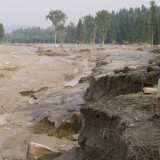

Well, here it is 10 months later. All issues settled? Mine back in production?
I guess it was just a tempest in a teapot (whatever that means). Good old Mother Nature will kiss it better and (hopefully) all will be forgiven and forgotten in a couple of generations.
Meanwhile, lets get on with Red Chris and see what kind of havoc we can wreak there!
alexandra morton speaking from site of spill, very honest and powerful!
https://www.youtube.com/watch?v=NpZOLkIaOnY
Christy Clark’s arrival in Likely and her subsequent ‘spin job” was for the media.
She has zero interest in the people and or the environment.
This is merely damage control for her friends ( and campaign contributors) to placate a pliant media and an uninformed public.
The water is safe to drink! Dont you people get it? Go about your business , there’s nothing to see here………..
I have been contacting the card and more about testing the air. They keeping passing it back and forth. The reason I have been calling is because 4 out of 6 adults that live on our property have complained about sore throats. 2 grandkids getting headaches, 2 vomiting for a day. The Moe informed me they did not have the equipment to test and it was liquids that came down. Next time I called Moe told me it is smoke from fires. I have now been informed there are others with symptoms also. Hope it is not fromthis but would like to know ffor sure. I have been so stressed because we are told to call and they will help or answer questions. Not sure what to do now.
There has to be some group of lawyers who will stand up for the citizens of this Province and in doing so, bring down a government that has not protected our land, our people, or our wildlife. Failing that each of us have a responsibility to keep this information alive as our community is next. I am writing from Vancouver Island where a coal mine is being planned. Another disaster, supported by our Provincial Government all in the name of profit and jobs.
So there is hope this is going to be dealt with?, Not forgotten? Do really people on the top – responsible – think we believe that everything is OK? And who is going to receive the penalty of 1 million dollars from Imperial Metals? Who is going to answer these questions and many others
Vera…. that is to be their fatal mistake, they truly think we believe that everything is O.K.
You do not “air” on the side of caution, you “err” on the side of caution.
And neither that mining company nor the province did that. They work on the “fast, cheap, and dirty” business plan, not one which would adequately protect the environment. Human life is cheap to them. Non-human life isn’t even considered.
If there is such a thing as “sin”, then this surely qualifies as such.
Shame on them.
Of course – thank you for catching that Anne. Corrected.
Midnight Aug14
Thanks Damien,
I just returned from a packed hall meeting in Likely hosted by Mt. Polley Mine VP and company biologist. Sure wished I had this article before I went.
The Highlights (if there is such a thing in these tragic circumstances) :
– eventhough the corp ended the provision of trucked in water for local residents (based on govt ‘safe’ water declaration) most local residents aren’t believing it and they demanded the continued provision of water.
– many residents have been meeting and planning on getting in the queue for a potential class action suit
– other examples of skin and health reactions were related to the corp with no mention whatsoever of the chemical stew that you write about.
– eventhough BC MOE reps were in the room they refused to comment.
– little or zero efforts to assess or determine the impacts of toxic and heavy metals bio accumulation.
– corp agreed to host information meetings in other downstream communities. We need to really move on this – I suggest Quesnel, Wllms Lk, Lytton, Lillooet, Hope, Chilliwack, Vancouver and Victoria.
– corp not willing to comment on financial reserves or bonds available for cleanup/compensation.
The Lowlights :
– 10K gallons per minute pumping of Polley Lk high water into Hazeltine Cr. flushing more toxic tailings mud into Quesnel Lake….this is madness!!!!!!
– VP talked about yesterday seeing happy fish leaping from Polley Lk. I think they were in a last ditch effort to get out of their unwelcomed newly created toxic tailings pond!!
– 23% completion of the plugging up of blown dam section
– ‘Our Corporate Responsibility blah blah blah good news blah blah blah clean water blah blah blah …..’
By this point I started to get an allergic reaction to the toxicity of the spin…
Thank you for the firsthand update of last night’s meeting, Doug.
It sounds like local folks are getting fairly fed up with what the company and government have to offer.
It will be interesting to see the kind of law suits that come out of this, as you suggest.
Please do keep us posted with your observations from the trenches.
The incompetence shown by our environment ministry is absurd, so much so it is downright criminal. One would think that air quality test would be in place immediately to asses the risk to not only human health but the health of all living things. The fact that it seems at this time no-one even has a handle on how much of these toxic chemicals were in the pond is mind-blowing . All people going to the site to do initial cleanup or testing should be equipped with hazmat gear at the least.
We need authority above that of Christy Clark or Mary Polak here, my God they certainly are the least qualified to make these decisions that could possibly safe lives. These people still encourage tourists to visit the area and promote it as pristine. Insane both of them.
So far what is obvious is that the government has made it their mission to protect mining interests and in doing so they have left many good people vulnerable. It wouldn’t be a surprise to have Bill Bennett in a week blaming these innocent people for simply choosing to live there.
We should never loose sight of the fact that it was because of these same peoples negligence that these residents now face a very uncertain and perhaps very unhealthy existence. They should be held accountable as the mine owners for what is to come!
Really interesting coverage, Damien. As awful and hideous as it is, we all need to know and investigate the toxic layers of the Mount Polley onion. And, the stench from this chemical and heavy metal disaster is as strong as the lies and misdirection from industry and government.
I sincerely hope that the people and wildlife that inhaled these, as yet, unidentified airborne, toxic contaminants won’t face serious health repercussions (i.e., kidney, liver disfunctions, etc.).
For more related discussion on the Mount Polley tailings disaster, listen to the Ian Jessop radio program interview with Glenda Ferris on:
August 14 – https://soundcloud.com/ian-jessop-cfax/august-14-1pm?in=ian-jessop-cfax/sets/ian-jessop (about 30 minutes in, after the 1:30 news summary)
August 7th – https://soundcloud.com/ian-jessop-cfax/august-7-1pm?in=ian-jessop-cfax/sets/ian-jessop (about 7 minutes in)